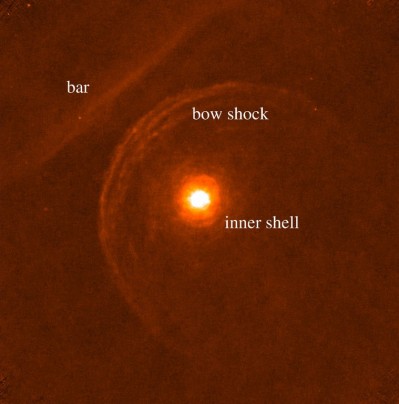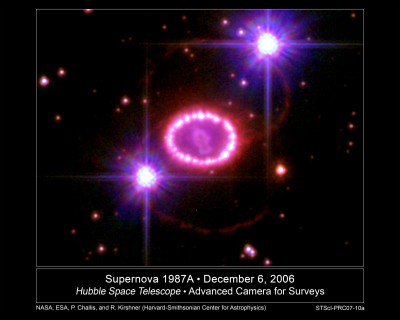Spectacular end proposed for the star Betelgeuse
The research has been published in a letter to Nature, available online at http://dx.doi.org/10.1038/nature13522
Betelgeuse has 600 times the diameter of the sun and is the tenth brightest star in the night sky. Since 2012 it has been known that the red supergiant, 600 light-years distant, is surrounded by a shell of dense gas and dust (see image to the right). Mackey and his colleagues describe in their Nature paper a new hypothesis for this formation. It is well known that red supergiants (and other stars) accelerate gas from their surface into space -- a stellar wind. UV radiation from interstellar space heats and ionizes this stellar wind, which the Bonn researchers modelled with computer simulations. This heat drives a shockwave, which decelerates the wind. In this way an almost static shell of gas and dust ejected by the star is formed, some distance away from Betelgeuse.
At the end of its life Betelgeuse will explode as a supernova. It's explosion will light up the heavens with a brightness comparable to the full moon, so bright that it may be visible both day and night. Exactly when this will happen is unfortunately impossible to predict. In the supernova explosion, the outer layers of Betelgeuse are accelerated outwards and flung into space. These stellar debris fly with thousands of kilometres per second towards the gaseous shell. The dense shell provides the target which will light up in a spectacular second "explosion" when the stellar remains crash into it, a year or more after ther star's demise.
"This process should also occur around other red supergiants", say the Bonn researchers. The mass of the shell could be much larger around these other stars, up to 5 solar masses according to calculations. This could explain why some supernova explosions are 10 to 100 times brighter than theoretically expected. When a star explodes within such a massive shell, the collision between the stellar debris and the shell is so violent that it is brighter than the supernova itself.
Supernovae should be observed every 100 years or so in the Milky Way. In a neighbouring galaxy, the Large Magellanic Cloud, a supernova explosion was discovered in 1987. Despite the enormous 160,000 light year distance to the supernova, it was bright enough to be visible to the naked eye, albeit only in dark skies at night. The blastwave from this explosion is still crashing into nearby clouds of gas, lighting up the bright rings seen with the Hubble Space Telescope in the image (see image above). Betelgeuse's shell provides the target for potentially a much more dramatic fireworks display.
The last supernova explosion in the Milky Way occurred some time ago: Italian observers noted in October 1604 a new object in the sky, that was brighter than all other stars. The German astronomer Johannes Kepler described the phenomenon in detail; since then the supernova has been named after him. The explosion of Betelgeuse would be much more spectacular for Earth's inhabitants -- the red supergiant is 30 times closer to us than Kepler's supernova.

Infrared image of Betelgeuse's surroundings.
The star is the bright central spot, surrounded by the inner shell that has now been explained by the Bonn researchers. Betelgeuse is flying through space (here towards the top left corner) at faster than the speed of sound, so its wind drives a bow shock ahead of it. When the star explodes as a supernova, debris from the star will collide with the inner shell and later the bow shock. (Credit: Vasilii Gvaramadze, using data from ESA/Herschel/PACS/L. Decin et al.)

A String of 'Cosmic Pearls' Surrounds an Exploding Star
[Credit: NASA, ESA, P. Challis and R. Kirshner (Harvard-Smithsonian Center for Astrophysics)]
The research has been published in a letter to Nature, available online at http://dx.doi.org/10.1038/nature13522
Betelgeuse has 600 times the diameter of the sun and is the tenth brightest star in the night sky. Since 2012 it has been known that the red supergiant, 600 light-years distant, is surrounded by a shell of dense gas and dust (see image to the right). Mackey and his colleagues describe in their Nature paper a new hypothesis for this formation. It is well known that red supergiants (and other stars) accelerate gas from their surface into space -- a stellar wind. UV radiation from interstellar space heats and ionizes this stellar wind, which the Bonn researchers modelled with computer simulations. This heat drives a shockwave, which decelerates the wind. In this way an almost static shell of gas and dust ejected by the star is formed, some distance away from Betelgeuse.
At the end of its life Betelgeuse will explode as a supernova. It's explosion will light up the heavens with a brightness comparable to the full moon, so bright that it may be visible both day and night. Exactly when this will happen is unfortunately impossible to predict. In the supernova explosion, the outer layers of Betelgeuse are accelerated outwards and flung into space. These stellar debris fly with thousands of kilometres per second towards the gaseous shell. The dense shell provides the target which will light up in a spectacular second "explosion" when the stellar remains crash into it, a year or more after ther star's demise.
"This process should also occur around other red supergiants", say the Bonn researchers. The mass of the shell could be much larger around these other stars, up to 5 solar masses according to calculations. This could explain why some supernova explosions are 10 to 100 times brighter than theoretically expected. When a star explodes within such a massive shell, the collision between the stellar debris and the shell is so violent that it is brighter than the supernova itself.
Supernovae should be observed every 100 years or so in the Milky Way. In a neighbouring galaxy, the Large Magellanic Cloud, a supernova explosion was discovered in 1987. Despite the enormous 160,000 light year distance to the supernova, it was bright enough to be visible to the naked eye, albeit only in dark skies at night. The blastwave from this explosion is still crashing into nearby clouds of gas, lighting up the bright rings seen with the Hubble Space Telescope in the image (see image above). Betelgeuse's shell provides the target for potentially a much more dramatic fireworks display.
The last supernova explosion in the Milky Way occurred some time ago: Italian observers noted in October 1604 a new object in the sky, that was brighter than all other stars. The German astronomer Johannes Kepler described the phenomenon in detail; since then the supernova has been named after him. The explosion of Betelgeuse would be much more spectacular for Earth's inhabitants -- the red supergiant is 30 times closer to us than Kepler's supernova.

Infrared image of Betelgeuse's surroundings.
The star is the bright central spot, surrounded by the inner shell that has now been explained by the Bonn researchers. Betelgeuse is flying through space (here towards the top left corner) at faster than the speed of sound, so its wind drives a bow shock ahead of it. When the star explodes as a supernova, debris from the star will collide with the inner shell and later the bow shock. (Credit: Vasilii Gvaramadze, using data from ESA/Herschel/PACS/L. Decin et al.)

A String of 'Cosmic Pearls' Surrounds an Exploding Star
[Credit: NASA, ESA, P. Challis and R. Kirshner (Harvard-Smithsonian Center for Astrophysics)]
- 11.08.2014